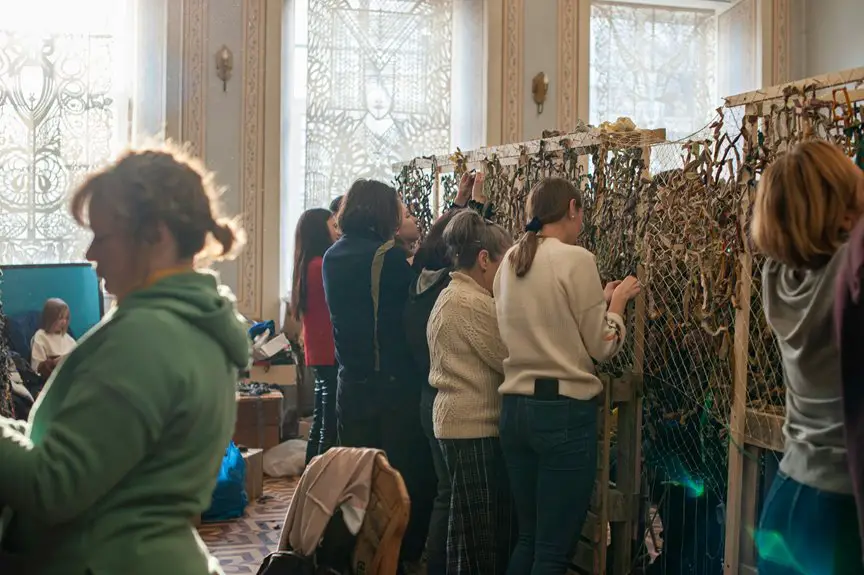If your project needs bold, textured lace with raised patterns, guipure lace is a great choice—it’s sturdy and visually striking, perfect for statement pieces and structured designs. But if you want delicate, intricate details with a soft, lightweight feel, chantilly lace offers elegance and romantic finesse, ideal for overlays and subtle accents. Both require gentle care, but your choice depends on the look and feel you’re after. Explore further to find which lace suits your style and needs best.
Table of Contents
Key Takeaways
- Choose Guipure lace for bold, raised floral or geometric patterns needing texture and structure in bridal or decor projects.
- Opt for Chantilly lace when seeking delicate, intricate designs with lightweight, sheer elegance for gowns, veils, or lingerie.
- Guipure lace is heavier and more durable, ideal for statement sleeves, overlays, or decorative appliqués requiring tactile dimension.
- Chantilly lace offers soft, transparent fabric that drapes smoothly, perfect for subtle inserts and romantic, ethereal aesthetics.
- Consider care needs, fabric weight, and project purpose: Guipure suits structured styles, Chantilly favors delicate, flowing designs.
History and Origins of Guipure Lace
Although you mightn’t realize it, guipure lace has a rich history dating back to the 16th century in Europe.
You’ll find that this lace style emerged as a popular form of needlework prized for its bold, open patterns connected by bars or plaits rather than a net background.
When you look at guipure lace, you notice how its thick motifs create a striking texture, making it stand out from other laces.
Originally, it was crafted in Italy and France, where artisans perfected the technique by hand.
Handcrafted by skilled artisans in Italy and France, guipure lace showcases timeless artistry and meticulous technique.
If you’re considering guipure lace for your project, knowing its roots helps you appreciate its sturdy yet elegant character, which has made it a favorite in fashion and décor through the centuries.
History and Origins of Chantilly Lace
While guipure lace boasts bold patterns, Chantilly lace charms you with its delicate, intricate designs that date back to the 17th century in France.
Originating from the town of Chantilly, this lace became renowned for its fine craftsmanship and elegant floral motifs. You’ll find it was traditionally handmade using bobbins on a lace pillow, creating lightweight fabric prized by French aristocracy.
Over time, Chantilly lace gained popularity across Europe, especially during the 18th and 19th centuries, adorning gowns and accessories with its refined beauty.
If you appreciate history woven into fabric, Chantilly lace offers a timeless connection to French artistry and sophistication, making it a graceful choice for your project.
Distinctive Features of Guipure Lace
Guipure lace stands out with its bold, raised patterns connected by bars or plaits rather than a net background. When you choose guipure lace, you’re picking a fabric that’s both sturdy and visually striking.
It offers a tactile dimension, making your project pop with texture and depth. You’ll notice its heavier feel compared to other laces, which means it holds shape well, perfect for structured designs.
Here’s what makes guipure lace distinctive:
- Thick, raised motifs connected by bridges or bars
- No net or mesh background, just open spaces
- Durable and less delicate than other laces
- Often features floral or geometric patterns
- Adds texture and dimension to garments or decor
This lace is ideal when you want bold elegance that lasts.
Distinctive Features of Chantilly Lace
Chantilly lace features delicate, fine patterns set against a sheer mesh background, giving it an airy and elegant appearance.
When you look closely, you’ll notice its intricate floral designs outlined with subtle cordonnet threads, which add definition without bulk. This lace is lightweight and soft, making it comfortable to wear and ideal for adding a touch of sophistication.
Unlike heavier laces, Chantilly’s transparency allows your design to shine through, creating a beautiful interplay of skin and fabric.
You’ll also appreciate its versatility; it drapes smoothly and holds intricate detail well.
If your project requires refined elegance with delicate detailing, Chantilly lace offers that perfect balance of beauty and subtlety.
Common Uses for Guipure Lace
You’ll often find guipure lace enhancing bridal and evening wear with its bold patterns and texture.
It also adds an elegant touch when used in home decor accents like table runners or curtains.
Let’s explore how its unique style fits these uses perfectly.
Bridal and Evening Wear
When selecting lace for bridal or evening wear, you’ll appreciate how this bold, textured fabric adds striking detail to any gown.
Guipure lace, with its intricate patterns and sturdy structure, stands out beautifully on formal dresses. It enhances elegance while offering durability and dimension. You can easily incorporate it into various design elements to create a sophisticated look that turns heads.
Consider using guipure lace for:
- Full lace overlays on wedding gowns
- Statement sleeves or bodices
- Dramatic evening dress panels
- Decorative appliqués for necklines and hems
- Bold accents on veils and accessories
Choosing guipure lace lets you craft garments that balance classic charm with contemporary flair, perfect for your special occasion.
Home Decor Accents
Although guipure lace is often celebrated in fashion, it also brings a unique charm to home decor accents. You’ll find its bold patterns perfect for adding texture and elegance to items like curtains, table runners, and throw pillows.
Unlike delicate Chantilly lace, guipure’s sturdy, raised motifs stand out beautifully on upholstery or lampshades, creating a statement piece in any room. When you use guipure lace in home decor, you get durability without sacrificing style.
It’s especially great for projects where you want lace to be noticed and appreciated up close. So, if you want to elevate your living space with intricate detailing that holds up over time, guipure lace is an excellent choice for your home accents.
Common Uses for Chantilly Lace
When you choose Chantilly lace, you’re picking a fabric often seen in bridal wear thanks to its delicate beauty.
You’ll also find it adding elegant details to evening gowns and enhancing lingerie and accessories.
Let’s explore how this lace brings sophistication to these special pieces.
Bridal Wear Popularity
If you’re considering lace for your wedding dress, Chantilly lace stands out for its delicate and intricate patterns that add timeless elegance.
You’ll find it popular among brides who want a romantic, soft look without heavy texture. Its fine netting and detailed floral designs create a light, airy feel perfect for bridal wear. Designers often choose Chantilly lace to enhance gowns with subtle sophistication.
You can incorporate Chantilly lace in:
- Veils, providing a sheer, elegant overlay
- Sleeves, adding delicate detail without bulk
- Bodices, offering intricate decorative patterns
- Overlays on skirts for a refined finish
- Trim and edging to accentuate gown silhouettes
Choosing Chantilly lace means embracing classic beauty that elevates your bridal look effortlessly.
Evening Gown Details
Since Chantilly lace offers delicate patterns and a lightweight texture, it works beautifully in evening gowns to add elegance without overwhelming the design.
When you choose Chantilly lace, you can highlight intricate details like scalloped edges and floral motifs that enhance necklines, sleeves, and bodices. Its sheer quality lets you play with layering, creating subtle contrasts that elevate your gown’s sophistication.
You’ll find it ideal for overlay panels or subtle inserts, giving your dress a romantic, ethereal feel. Plus, Chantilly lace drapes smoothly, so it complements flowing silhouettes perfectly.
If you want your evening gown to exude timeless charm with delicate artistry, Chantilly lace is a go-to choice that adds refined texture while keeping the look light and graceful.
Lingerie and Accessories
Beyond evening gowns, Chantilly lace shines in lingerie and accessories, where its delicate patterns and sheer texture bring a touch of luxury and femininity.
When you choose Chantilly lace for lingerie, you enhance comfort and elegance without sacrificing breathability. It’s perfect for pieces that need a soft, romantic feel while still looking sophisticated.
Accessories benefit from its intricate design, adding subtle charm and refinement. Whether you want to create a standout statement or add delicate detail, Chantilly lace adapts beautifully.
Consider using Chantilly lace for:
- Lingerie sets and bralettes
- Delicate camisoles
- Sheer gloves
- Bridal veils and mantillas
- Decorative scarves and shawls
This lace’s versatility makes it a go-to for intimate, elegant touches.
Care and Maintenance Tips for Both Laces
Although Guipure and Chantilly lace differ in structure, both require gentle care to preserve their delicate beauty. When you handle either lace, avoid harsh detergents and opt for hand washing in cool water instead. Lay them flat to dry, never wring or twist, to prevent damage. Store your lace away from direct sunlight to avoid fading.
| Care Aspect | Guipure Lace | Chantilly Lace |
|---|---|---|
| Washing | Hand wash, mild detergent | Hand wash, mild detergent |
| Drying | Lay flat, avoid twisting | Lay flat, avoid twisting |
| Storage | Cool, dark place | Cool, dark place |
Follow these tips, and your lace will stay stunning for years.
How to Choose the Right Lace for Your Project
What factors should you consider when selecting lace for your project? Choosing between guipure and Chantilly lace depends largely on your design goals and practical needs.
Guipure lace offers bold, raised patterns ideal for statement pieces, while Chantilly lace provides delicate, intricate designs perfect for subtle elegance.
Think about the fabric’s weight, texture, and how it complements your project’s style. Also, consider care requirements and budget constraints.
Here’s what to keep in mind:
- Purpose: formalwear, casual, or décor
- Texture: heavy and structured vs. light and airy
- Pattern style: bold motifs or fine, detailed designs
- Durability and ease of maintenance
- Cost and availability
Frequently Asked Questions
Can Guipure Lace Be Dyed Different Colors Easily?
You can dye guipure lace different colors, but it might take some effort since it’s thicker and denser. Make sure to test a small piece first, so you don’t risk uneven results or damage.
Is Chantilly Lace Suitable for Outdoor Wear?
You’d think Chantilly lace could survive a hurricane, but it’s delicate and best kept indoors. For outdoor wear, you’ll want sturdier fabrics since Chantilly’s fine threads can snag and wear quickly in rough conditions.
What Is the Average Price Range for Authentic Guipure Lace?
You’ll find authentic guipure lace typically costs between $20 to $100 per yard, depending on quality and design complexity. Don’t forget to check for craftsmanship details to guarantee you’re getting genuine lace at a fair price.
Are There Eco-Friendly Alternatives to Traditional Chantilly Lace?
You can find eco-friendly Chantilly lace alternatives made from organic cotton or recycled fibers. These options reduce environmental impact while maintaining delicate beauty. Look for certifications to guarantee sustainable sourcing and support ethical production practices.
Can Guipure Lace Be Machine Washed Without Damage?
You shouldn’t machine wash guipure lace because its intricate patterns can get damaged. Instead, you should hand wash it gently with mild detergent and cold water to keep it looking beautiful and intact for longer.
- Does Chiffon Fabric Stink - July 15, 2025
- Does Chiffon Fabric Affect the Economy - July 15, 2025
- Does Cotton Fabric Have a Nap - July 15, 2025







